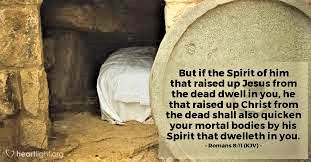
Photo and cartoon caption contests are a big thing on social media. Businesses use them to generate traffic on their sites and help people remember their brand. The idea is to bring your own unique interpretation to a far-out concept.
The Bible is full of far-out imagery generated by the prophets in the Old Testament and by Jesus in the New to help them teach the people of their day using concepts on which they could get a strong mental grasp. Unfortunately, people with their own messages to sell have often tried hijacking those images and attaching their own captions to draw traffic to their own cause. Sunday’s first reading offers an example. It comes from the Book of Ezekiel (Ez 37:12-14). In it, the Prophet uses graphic imagery to sell people on the concept of unity under one God. In Sunday’s excerpt, he uses an image that Jesus would later bring to life with his own resurrection:
Then you shall know that I am the LORD, when I open your graves and have you rise from them, O my people! I will put my spirit in you that you may live.
Following this graphic image, Ezekiel uses another, employing the fusion of two sticks into one to depict the unification of Israel (EZ 37:16-19).
As for you, son of man, take one stick and write on it, “Judah and those Israelites associated with it.” Then take another stick and write on it: “Joseph, Ephraim’s stick, and the whole house of Israel associated with it.” Join the two sticks together so they become one stick in your hand. When your people ask you, “Will you not tell us what you mean by all this?” answer them: Thus says the Lord GOD: I will take the stick of Joseph, now in Ephraim’s hand, and the tribes of Israel associated with it, and join to it the stick of Judah, making them one stick; they shall become one in my hand.
Ezekiel took no chances for misinterpretation and gave instructions for settling any confusion among his audience. “They shall be no more two nations, neither shall they be divided into two kingdoms any more at all” (Ez 37:22). But leave it to false “prophets” to make a caption contest out of God’s inspiration. Others have used this stick imagery to claim the stick of Joseph as theirs and therefore worthy of being parallel in stature with the Bible, represented by the stick of Judah. But they altered this image of two united sticks into two separate sticks that make up a scroll—with their doctrine dispensed between them.
At least when Jesus’s disciples heard their Master use his graphic imagery while teaching, they had direct access to the source for an interpretation. Sunday’s gospel reading (Jn 11:1-45) offers the perfect example to further illustrate Ezekiel’s grave imagery. Only difference is, with Jesus, wild imagery like that often became miraculously real—and his overwhelmed students didn’t always get it when their Master used plain language to caption the miraculous. They would soon realize that the resurrection of Lazarus was not just a parable, and he was not just sleeping. They needed a caption from Jesus to explain the miracle of life they were about to witness.
“Master, if he is asleep, he will be saved.” But Jesus was talking about his death, while they thought that he meant ordinary sleep. So then Jesus said to them clearly, “Lazarus has died. And I am glad for you that I was not there, that you may believe. Let us go to him.”
And with the words, “Lazarus, come out!,” the disciples understood the meaning of humanity’s redemption—and the reality of Christ’s miracles.
In Sunday’s second reading (Rom 8:8-11), Paul makes the miracle of resurrection personal for all who would learn about it through his letters:
If the Spirit of the one who raised Jesus from the dead dwells in you, the one who raised Christ from the dead will give life to your mortal bodies also, through his Spirit dwelling in you.
Paul was a winner at interpreting his Master’s teachings and tempering our fear of death. So while we’re in this life, let’s use those winnings to set each other up for a joyful retirement.
–Tom Andel